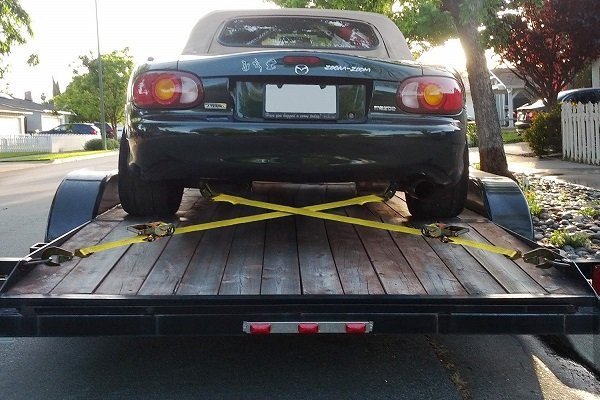Hooking up a car to a trailer can seem like a daunting task, but have you ever considered that it could be as simple as tying your shoelaces, with a little concentration and a little caution?
Properly securing a car to a trailer is crucial to avoid possible slippage, displacement or even detachment during transport. Failure to secure the vehicle properly can lead to serious consequences, such as damage to the car and risk of accidents.
Essential tools
Ratchet straps

One of the most effective tools for securing cars during transport is the ratchet strap. Designed to apply tension and hold items securely in place, ratchet straps are ideal for ensuring your load stays in position throughout your journey. When choosing ratchet straps, it is important to consider the following factors:
- Strength and load capacity: Make sure the ratchet straps are of adequate strength, with a working load limit greater than the total weight of the car.
- Length and width: Select ratchet straps with an appropriate length to wrap around the car and reach the trailer anchor points. Wider straps generally offer greater stability.
- Strap material: Opt for ratchet straps made of durable polyester fiber, as nylon straps tend to have more stretch, which could cause the car to come loose during transport.
Chain binder

For heavier vehicles and equipment, chain binders can be more effective due to their steel construction, which provides greater durability and a reduced risk of breakage. When used in conjunction with ratchet straps, chain binders can secure a car to a trailer. However, it is important to note that this may not be the optimal or recommended method.
Hook up the car
Checking
Before starting, make sure the trailer, car and ratchet straps are in good condition. Inspect the ratchet straps for any signs of damage such as cuts, mold or burn marks. If any of these signs are present, replace the belts promptly.
Placement of the car
Next, we need to properly place the car on the trailer. It’s similar to putting a pizza in the center of a baking tray. This step is crucial to maintain balance and stability during transit. Here are the steps to do it:
- Prepare the trailer: Before starting, make sure the trailer is level and located on firm, level ground. This will ensure that the trailer does not tilt or move unexpectedly while you are loading the car.
- Align the car: Align the car with the trailer ramps. If you’re doing it alone, it can help to use a spotter or a guide to make sure the wheels stay on track. Be very careful when driving the car to the trailer to avoid damage.
- Center the car: Once the car is on the trailer, the goal is to balance its weight as evenly as possible. The car must be centered from side to side. You also want to achieve good front-to-back balance. Ideally, a little more weight should be toward the front of the trailer (the side attached to the towing vehicle), but not so much that it significantly affects the handling of the towing vehicle.
- insure the car: Put the car in park, set the parking brake and turn off the engine. Also, it can be helpful to use wheel chocks on the wheels that are not tied first to prevent the car from moving while you secure it to the trailer.

Installation of the straps
Front straps
For the front of the car, the ratchet strap should wrap around the front control arm near the bottom of the wheel. And attach the hook to the two front ends of the strap.

Connect the other end of the strap to the appropriate anchor points on the trailer. Take up any excess slack in the strap and use the ratchet to adjust the tension until the strap is tight.

To secure the excess length of strap, slide it through the center of the ratchet, pass it through the metal loop at the end of the strap, and tie a knot at the bottom of the remaining slack.

Tips: You need to use both hands to tighten the ratchet when pulling, which means the straps are tight enough.
Rear straps
For the rear, attach the ratchet straps to the rear axle on the right side of the differential. Make sure the end of the strap is over and near the rear sway bar. Attach the hook to both ends of the strap wrapped around the shaft. Repeat the process on the other side of the shaft.

After attaching the straps, tighten them by connecting the rear end of the straps to opposite anchor points on the trailer. This will create an X-shaped configuration, improving the stability of the security system.
Verifying the configuration
After all that hard work, we have to review everything. This final inspection ensures that your car is ready for safe traffic.
The post How To Hook Up A Car To A Trailer appeared first on Semi Trailer Manufacturer, Semi Trucks For Sale | Three horse trailer.

